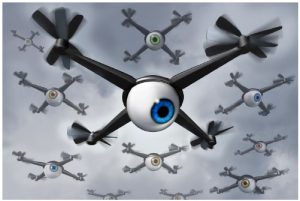EMERGING TECHNOLOGIES CAN TRANSFORM INDIAN POLICING

The flickering blue and white strobe lights cast their familiar dance across the chaotic Chennai traffic. For decades, this scene has defined the image of Indian policing – a solitary constable battling snarled rickshaws and honking tempos, fueled by grit and intuition. But as the 21st century surges forward, a transformation is taking place, a quiet revolution fueled not by adrenaline and instinct, but by the potent spark of emerging technologies.
Blockchain: The Indelible Ledger of Truth
Imagine a world where evidence, once a fragile chain vulnerable to tampering, is secured in the incorruptible embrace of blockchain. Every step, from crime scene capture to analysis, is etched in an immutable record, fostering trust between the police and the public. In India, pilot projects are already exploring the potential of blockchain to secure and track evidence in land disputes and wildlife poaching cases. Expanding this to encompass broader areas of crime investigation can create a transparent and tamper-proof chain of custody, building public confidence in the judicial process.
AR & VR: Bridging the Gap Between Reality and Training
Police training often struggles to replicate the complexities of real-world situations. This is where Augmented Reality (AR) and Virtual Reality (VR) can step in. Imagine officers donning VR headsets and stepping into immersive simulations of hostage situations, riot control scenarios, or intricate forensic investigations. AR technology can overlay digital information onto real-world crime scenes, allowing officers to visualize ballistics trajectories or reconstruct shattered evidence in situ. By bridging the gap between training exercises and the unpredictable nature of real-world crime, AR and VR can equip officers with the skills and confidence they need to tackle any situation.

Chatbots: A Virtual Hand in Times of Need
For victims of online harassment or cybercrime, reporting an incident can be a daunting and often stigmatizing experience. Here, chatbots can offer a safe and supportive virtual hand. Imagine a multilingual chatbot, trained in cultural nuances and legal procedures, providing guidance and resources to victims in the privacy of their own homes. Chatbots can automate mundane tasks like filing initial reports, freeing up human officers to focus on complex investigations. In remote areas with limited access to police stations, chatbots can become a vital bridge between vulnerable communities and the justice system.
3D Printing: From Bullets to Bandages
The versatility of 3D printing extends far beyond creating novelty keychains. In Indian policing, it has the potential to revolutionize forensics, disaster response, and even equipment manufacturing. Imagine 3D-printed models of crime scenes, allowing investigators to meticulously analyze and recreate complex situations. In the aftermath of natural disasters, 3D-printed shelters and medical supplies can be rapidly deployed to remote areas, saving lives and providing much-needed relief. Even police equipment like custom-fit body armor or specialized tools can be produced on-demand, reducing costs and improving officer safety.

ANPR: Tracking the Invisible Threads
Traffic snarls and stolen vehicles have long plagued Indian roads. But with Automatic Number Plate Recognition (ANPR) technology, these challenges can be tackled head-on. Imagine a network of intelligent cameras scanning license plates in real-time, identifying stolen vehicles, expired registrations, and even drivers with outstanding warrants. This can significantly reduce traffic congestion by automatically enforcing parking regulations and lane discipline. Moreover, stolen vehicles can be tracked across state borders in real-time, improving recovery rates and deterring criminal activity.
Nanotechnology: A Forensic Revolution in Your Pocket
Forensic investigations often require bulky and expensive equipment, limiting their accessibility in remote areas. This is where nanotechnology comes into play. Imagine mobile phones equipped with nano-based sensors that can analyze blood samples, detect narcotics, and even identify unknown substances on the spot. This can revolutionize crime scene investigations in rural areas, allowing for immediate analysis and evidence gathering, ultimately improving case resolution rates.

Drones: Eyes in the Sky, Guardians on the Ground
From patrolling vast coastal borders to monitoring large gatherings and protests, drones offer a unique bird’s-eye view of security situations. Imagine drones equipped with high-resolution cameras and night-vision capabilities, providing real-time aerial surveillance of crime scenes, illegal activities, and natural disasters. In remote areas, drones can deliver essential supplies and medical aid to inaccessible locations, acting as lifelines in times of crisis. However, concerns regarding privacy and misuse must be addressed through robust regulations and ethical frameworks.

Robots: Partners in Precision and Peril
While futuristic visions of robot police patrolling city streets may remain in the realm of science fiction, robots have the potential to assist officers in specific high-risk or hazardous situations. Imagine robots equipped with bomb disposal capabilities, entering confined spaces deemed too dangerous for human officers. These robots can also be used for crowd control, deploying non-lethal tactics and minimizing the risk of human injury.
However, the deployment of robots must be carefully considered, ensuring that they do not replace human judgment and exacerbate ethical concerns. Transparency and public discourse are crucial in determining the appropriate role of robots in Indian policing.
Challenges and Solutions: Navigating the Technological Crossroads
This technological wave, while promising, is not without its challenges. Infrastructure limitations, particularly in rural areas, can hinder the seamless integration of these technologies. Affordability also remains a concern, and ensuring equitable access across different regions and police units is crucial. Data privacy and security are paramount, requiring robust frameworks to protect citizen information from misuse and abuse. Additionally, concerns regarding ethical considerations, such as bias in algorithms and potential for surveillance, must be addressed proactively through public discussion and policy interventions.
To overcome these challenges, collaboration is key. Public-private partnerships can leverage private sector expertise and resources to bridge the technology gap. Capacity building programs can equip officers with the skills and knowledge needed to operate and analyze these technologies effectively. Open-source software and localized technology development can reduce reliance on expensive proprietary solutions and ensure wider accessibility. Finally, robust data governance frameworks, coupled with public awareness campaigns, can build trust and transparency in the use of these technologies.
Success Stories: Building the Pillars of a Brighter Future
India is already witnessing the transformative power of technology in policing. In Kerala, drones are being used to monitor coastal security, while Karnataka is utilizing ANPR cameras to improve traffic management. The state of Telangana has implemented a citizen engagement app, enabling seamless communication between the public and the police. These success stories demonstrate the potential of technology to address specific challenges and improve police efficiency. By scaling up these initiatives and learning from best practices around the world, India can build a robust foundation for a tech-driven future of policing.

A Call to Action: Weaving Technology with Trust
This transformation is not simply about adopting gadgets and algorithms; it’s about forging a new relationship between the police and the public. Technology can be a powerful tool for building trust and transparency, but it must be wielded with human values at its core. Empathy, compassion, and respect for human rights must remain the guiding principles of Indian policing, regardless of the technological advancements we embrace.
Therefore, I call upon all stakeholders – police officers, citizens, policymakers, and technologists – to come together and shape this future responsibly. Let us engage in open dialogue, address concerns proactively, and ensure that technology serves as a bridge, not a wall, between the police and the communities they serve. By working together, we can build a safer, more just India, where innovation empowers police officers, protects citizens, and builds a future where technology is not feared, but celebrated as an ally in service of a better tomorrow.
Together, let us transform Indian policing, not just for ourselves, but for the generations to come.
 Dr K. Jayanth Murali is a retired IPS officer and a Life Coach. He is the author of four books, including the best-selling 42 Mondays. He is passionate about painting, farming, and long-distance running. He has run several marathons and has two entries in the Asian book of Records in full and half marathon categories. He lives with his family in Chennai, India. When he is not running, he is either writing or chilling with a book.
Dr K. Jayanth Murali is a retired IPS officer and a Life Coach. He is the author of four books, including the best-selling 42 Mondays. He is passionate about painting, farming, and long-distance running. He has run several marathons and has two entries in the Asian book of Records in full and half marathon categories. He lives with his family in Chennai, India. When he is not running, he is either writing or chilling with a book.
